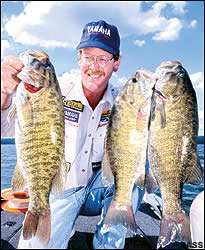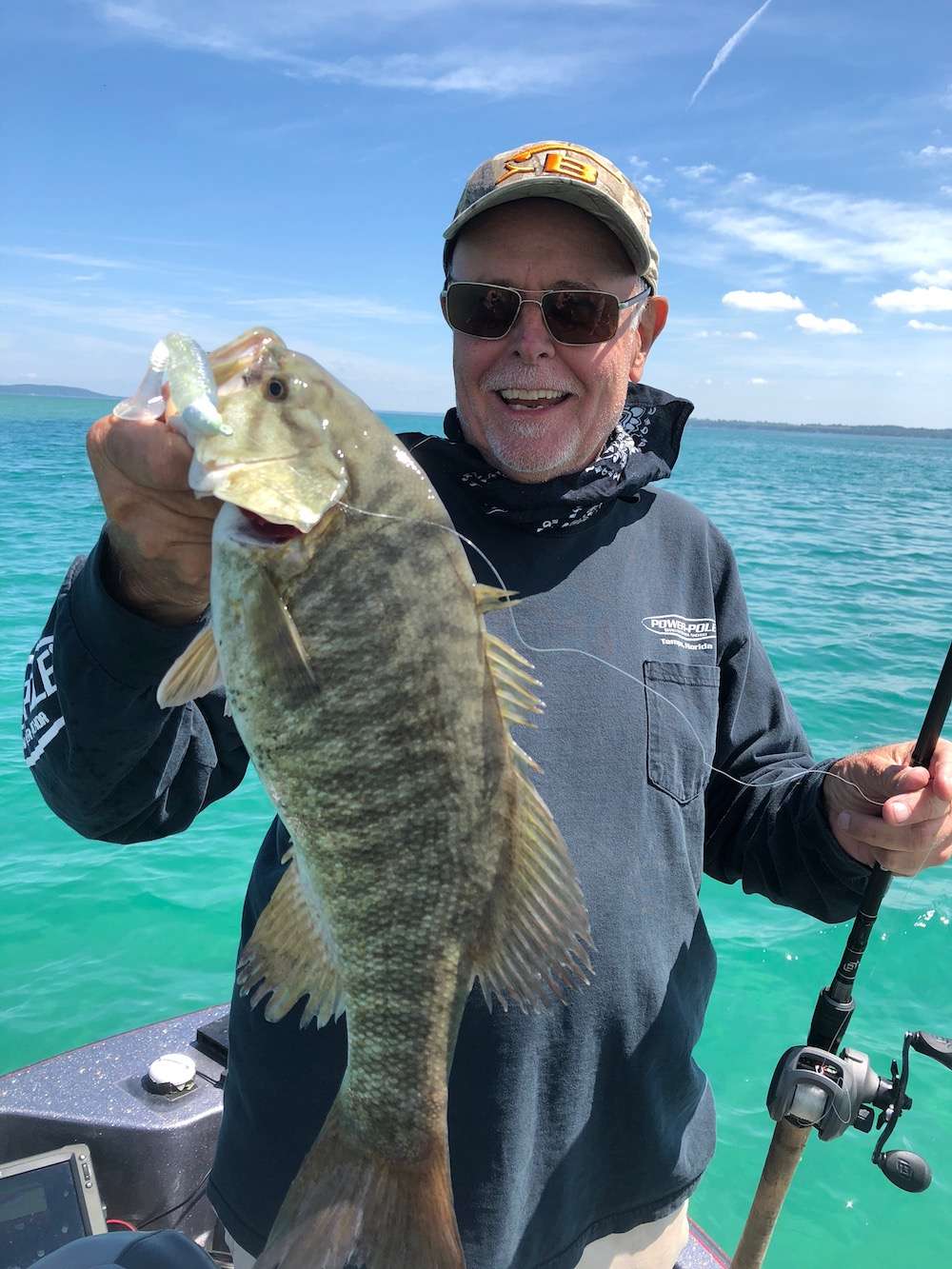
When describing perfect smallmouth bass water, “crystal clear” would probably be the adjective most anglers would mention. But some of the best smallmouth fishing can be experienced in venues with a water color closer to Tennessee sippin’ whiskey than gin. Bassmaster cornered two veteran smallmouth guides, Jim Duckworth of Lebanon, Tenn., and Steve Hacker of Florence, Ala., and asked them to expound on their methods for catching giant smallies from murky water.
BASSMASTER: What’s the average water visibility where you guys normally fish for smallmouth?
DUCKWORTH: I fish four mid-Tennessee smallmouth reservoirs: Dale Hollow, which has 10- to 20-foot visibility; Center Hill, 5 to 10 feet; Priest Lake, about 5 feet; and the Cumberland River below Old Hickory dam, 1 to 3 feet. I’ve caught my biggest fish from the Cumberland River, including the 8-3 smallmouth I was pictured with on the cover of the June 2000 issue of Bassmaster.
HACKER: I mainly fish Pickwick Reservoir, a Tennessee River impoundment. Visibility is normally 2 to 3 feet. It’s loaded with 4- to 6-pound fish; my personal best weighed 7-15.
BASSMASTER: Many readers view the smallmouth bass as a clear water species, but you both catch plenty of big ones from dirty water. Do you think smallmouth might actually be more prolific and grow bigger in a murky environment than a clear one?
DUCKWORTH: My contacts at the Tennessee Wildlife Resources Agency tell me smallmouth in my area don’t grow any faster or bigger in murky water than in clear. However, they’re definitely more catchable in low visibility water because the turbidity provides them the concealment they need to ambush shallow prey.
HACKER: Jim, you’re right-on about the catchability issue. Smallmouth are shallower, less cautious and more aggressive in murky water, and therefore much easier to catch. This is especially true with big smallmouth, which are incredibly wary in clear water environments. You’ll often catch more lunker smallies in a single day from a murky lake or river than in an entire season from clear water.
BASSMASTER: You’ve both caught monster smallmouth from murky river-run reservoirs. Do you feel the smallmouth potential is greatest when the water is murky and moving, versus murky and slack?
DUCKWORTH: Current is a key element for big smallmouth in turbid reservoirs. It brings the fish shallower and positions them in predictable places. I can be on fish big-time in the Cumberland when they’re generating current from the upstream dam, but when they shut the water off, the bite usually dies within 30 minutes. I like a low to medium flow; this positions baitfish close to the banks and doesn’t hinder boat control. The bait scatters once generation stops.
HACKER: Smallmouth bunch up tighter to structure and cover when the water is moving versus slack; however, on Pickwick, I seldom catch ’em along the banks at any time — here, they relate to offshore humps, ledges and rockpiles instead.
BASSMASTER: Terms like “shallow” and “deep” can be misleading, especially to newcomers to bass fishing. At what depth range do you usually find smallmouth in murky reservoirs?
DUCKWORTH: In clear reservoirs like Dale Hollow, I’ve caught smallmouth down to 50 feet; 22 to 30 feet is common for big fish throughout the year, with the exception of the spawning season. Not to put anybody down, but most bass fishermen don’t know how to fish water this deep, which explains why relatively few fishermen catch big smallies from clear lakes. In the Cumberland River, I catch most of my quality fish from 2 to 12 feet.
HACKER: I’ve caught 7-pound smallmouth down to 18 feet at Pickwick, compared to 30 feet at nearby Wilson Lake, which is considerably clearer. If you figure they’ll be half as deep in a murky lake as in a clear lake, you’ll be in the ballpark.
BASSMASTER: Most bass anglers find that cold, murky water produces a very slow bite. Do you agree?
DUCKWORTH: I’ve caught good smallmouth down to 40 degrees from the Cumberland River, but only when the visibility is at least 3 feet, and only on suspending lures. Under these conditions, I like a suspending crankbait or a bright-colored hair jig fished under a bobber — a high-viz float ‘n’ fly. Dale Hollow regulars clean up during the winter on suspending jerkbaits; I’ve got to have at least 5-foot visibility on the Cumberland before I’m confident in them.
HACKER: I dislike cold, muddy water, but I don’t mind if it’s cold and stained. One of the best trips I ever had was when Pickwick was 39 degrees and murky; my client and I had 42 smallmouth on spinnerbaits and grubs by midafternoon. Moving water is always more conducive to an active smallmouth bite than slack water, regardless of the temperature or clarity.
BASSMASTER: What kinds of places are you fishing in murky reservoirs?
HACKER: Normally when you talk smallmouth locations, you have to categorize the discussion by seasons, but murky water is the great equalizer — it dictates smallmouth location more than any other factor; except heavy current. On Pickwick, if the current is strong and the water is murky, like it usually is, you can go to the same places and catch fish regardless of the season. December, July, March — it doesn’t matter — they’ll be in the same spots, as long as the water is stained and moving. As I mentioned before, I target mainly offshore humps, rockpiles and ledges, and almost never fish bank-oriented structure.
DUCKWORTH: My fish also are offshore-oriented. The part of the Cumberland where I fish for smallmouth is a lot narrower than the Tennessee River, and the fish relate strongly to classic smallmouth structures: flats, points, gravel bars, eddies, etc. In March, when they’re in prespawn mode, I normally fish 10 feet deep at the outer edges of flats and points. They spawn 3 to 8 feet deep, usually close to deeper water. In summer, they pull out to channel drops, but seldom move deeper than 15 feet. Moving water is cooler and more highly oxygenated than slack water, so in summer, they don’t have to go nearly as deep in a river as they do in a lake. In fall, they move onto the banks to gorge on baitfish — this is a tremendous time for topwater action. In winter, they like points, ledges and bluff banks in the 14- to 20-foot zone.
BASSMASTER: A heavy rain can trash a river overnight. When the water gets high and muddy, do you fish the same areas, or look for clearer water?
DUCKWORTH: It’s been my experience that the smaller fish, 4 pounds on down, will move to clearer water, but the big boys will hang tough and wait it out until conditions improve. I’ve caught some real wall-hangers from high, muddy water, but you’ve really got to slow down under these conditions. It also pays to fish smaller lures on lighter line to combat the drag created by intense current.
HACKER: For a while after it rains, Pickwick is often a uniform brownish color from bank to bank. When this happens, I’ve often found huge concentrations of smallmouth ganged up where a culvert or waterfall is dumping clear water into the system.
BASSMASTER: Veteran clear water smallmouth anglers know these fish often relate more to depth contours and baitfish schools than to cover. Does this hold true in murky water as well?
HACKER: Tightness to cover and reduction in roaming behavior are directly related to a reduction in water clarity. In water with visibility 2 feet or less, I often won’t get a strike unless I bump my lure off a stump or rock. Close may count in horseshoes, but not in murky water smallmouth fishing.
DUCKWORTH: I find smallies orient strongly to the bank in dirty water, something they seldom do in clear conditions. I suspect they aren’t using the bank as cover in the usual sense, but as a point of reference. Maybe they feel more comfortable sitting near a solid mass when their visibility is restricted.
BASSMASTER: Do smallmouth feed on the same types of forage in murky water as they do in clear water?
DUCKWORTH: Interesting question! I think they eat more crawfish than baitfish in turbid water. The proof is in your livewell. I’ve noticed smallmouth spit up shad in clear lakes, and crawfish parts in murky water. It would seem logical they’d eat more crawfish in turbid water, because they’re more bottom-oriented when visibility is restricted.
HACKER: I don’t think the turbidity factor has much of an effect on what they eat. Granted, a heavy rain might displace more crawfish and worms from riverbanks and feeder creeks into the system, but smallmouth will also gorge on shad passing through the spillway after flooding rains have turned the tailrace to chocolate. They’re opportunistic predators, and they’ll grab a meal when and where they can find it.
BASSMASTER: We’ve skirted around the issue of lures and approaches; let’s get specific on this topic.
HACKER: I’ve caught most of my big smallmouth on hair jigs of my own design. These range from ¼ to ½ ounce. I leave the hair tied long, giving the lure the impression of a baitfish. I fish them without trailers by popping them repeatedly off the bottom; white has been my most productive smallmouth color in dingy water. I also use spinnerbaits from ½ to 1 1/8 ounces, mostly in white or chartreuse. You can get away with bigger lures in murky water, but you need low diameter lines to overcome current drag. I use 8-pound mono with hair jigs, and up to 15-pound with spinnerbaits.
DUCKWORTH: I fish a lot of crankbaits for smallies, and love the Bandit 200 and 300 series in Texas red. I change the stock hooks to Daiichi Bleeding Bait trebles. When smallmouth are on flat gravel structure, I do well on a Rat-L-Trap. Besides red, I like chartreuse and chrome in murky water.
BASSMASTER: Any final words of wisdom for our smallmouth-crazed readers?
DUCKWORTH: Yeah — never let dirty water discourage you. Fish shallower and tighter to cover than you’re used to, and you’ll score a big smallie. Keep your drag loose!
HACKER: Remember that murky water is best when combined with strong current. I’ve had unbelievable smallmouth days, with flows as high as 250,000 cfs — that’s twice the volume of Niagara Falls! Just remember to zip up your pfd, and be careful out there.
Ed Note: Contact Jim Duckworth at 615-444-2283, or ducktrail@softek.net; Steve Hacker can be reached at 256-760-8090, or info@smallmouth.com.





